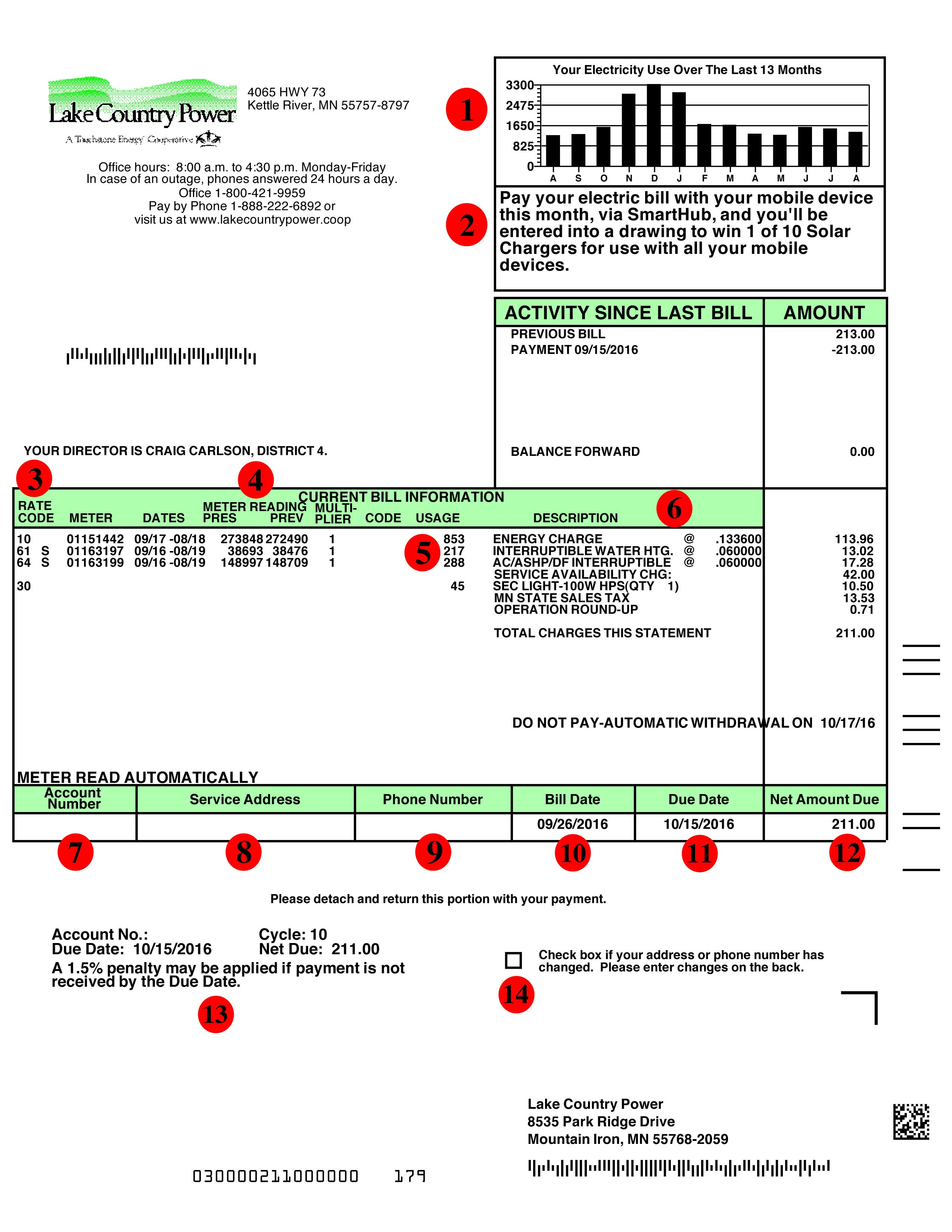Understanding Your Bill

-
Usage graph: This is a graph that shows your electricity usage for comparison purposes from one month to the next. You’ll notice that usage is lower during some months than others. On average, members use less electricity during the spring and fall months.
-
Message box: This box gives members information about energy saving ideas, upcoming member events and special services offered by Lake Country Power for co-op members. The box also provides helpful reminders, such as seasonal rate changes. Activity since last bill: This box shows the amount of the previous bill, your payments and the balance forward from previous month(s).
-
Rate code: The rate code identifies your classification of service. Residential, seasonal and commercial members all have different rate codes. If you’re on an Energy Wise® program like off-peak heating or cycled air conditioning, you’ll see a specific rate code assigned to these services as well. The rate code helps our billing personnel identify your service more quickly. The rate code also prints next to its meter number. Meter: This line represents the meter number for the meter that records your energy usage. Some homes have multiple meter numbers if they’re on an Energy Wise heating and/or cooling program.
-
Meter reading (present and previous): This area of the bill is reserved for recorded meter readings listing electric usage for the current billing period and previous billing statement. It may be split into service classifications denoting your rate code(s). Multiplier: The multiplier is applied to calculate the actual kilowatt-hours used during the billing period. A billing “multiplier” is used to determine the true amount of energy or demand recorded by a current transformer (CT) meter. A CT meter is a common meter designed to measure only a portion of the energy used. For example, a CT meter that records 1/20th of the energy passing through it would use a billing multiplier of “20” to determine actual usage. CT meter applications are most common for electric heat or commercial electric loads.
-
Actual energy usage: This shows the total kilowatt-hours (kWh) of electricity used during the billing period. A kilowatt-hour is a measure of electricity consumption equivalent to the use of 1,000 watts of power over a one-hour period. The average residential Lake Country Power member uses 800 kWh per month. To help figure your bill, the total number of kilowatt-hours used is multiplied by the energy charge.
-
Description: This part of the bill shows an itemized energy charge, which varies with your service classification or rate code. Also listed on the bill is a line item for the Service Availability Charge, which is a monthly fee to help defray specific costs not assigned with the amount of energy used. If you contribute small change each month to Operation Round Up, we also list this on your bill so you know how much you’re contributing to this charitable giving program. If your primary heat source is electricity, your usage from November until April is exempt from Minnesota sales tax.
-
Account number: This is your personal Lake Country Power account number that’s assigned to you when you become a member of the cooperative. Please refer to this account number when calling or e-mailing our service centers. If you have electric service with Lake Country Power at more than one location, you will have a different account number for that location also. Your account number is important when calling us to report a power outage, for director elections and to help us service you faster.
-
Service address: This is the address where the electric service is located.
-
Phone number: This is your personal phone number. Please be sure the number printed on your bill is always correct so we can locate you for service. If the number is not current as printed on your bill, contact us at 800-421-9959 or use the online form to update your account.
-
Bill date: This is the date your bill was calculated.
-
Due date: This is the date your payment is due. If your payment isn’t received on this date a 1.5% penalty charge may be applied.
-
Net amount due: This is the total balance due for your electric service.
-
Recap of information: This section states again your account number, due date, which billing cycle you’re assigned, the net amount due and information about a late penalty charge.
-
Check box: If your address or phone number changes, please check this box and enter the changes on the back of the remittance stub when you send your payment. Or update your account information online through an electronic form.





